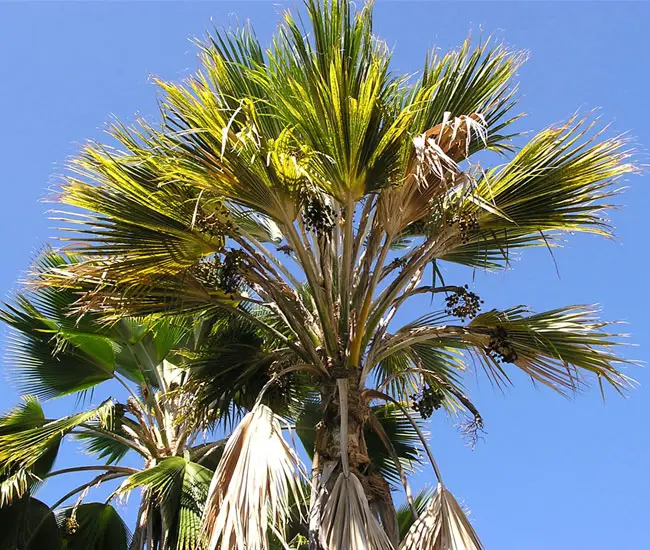
Healthy outdoor palm trees usually establish quickly, are easy to grow, and have very few problems. While it’s normal for palms to shed old brown fronds, if you notice a lot of brown, yellow, or drooping leaves, there is an issue. Figuring out why your palm tree is feeling under the weather can be a challenge.
Drawing from my many years of experience growing palm trees, the most common problems are overwatering, underwatering, nutrient deficiency, disease, insect attacks, fertilizer burn, or cold damage. A newly planted palm could also have brown or yellow fronds/tips due to “transplant shock.”
First of all, don’t panic.
There could be a number of reasons why your palm is not feeling well, but chances are, it’s a simple issue with everyday care that can be resolved. Let’s explore the following points to see if any of them apply.
1. Natural Browning
As mentioned earlier, palm trees naturally shed their lower fronds as new ones emerge from the center of the crown.
The aging leaves turn brown, dry up, and either drop to the ground or hang around until you remove them. Each type of palm has its specific number of fronds that remain green.
2. Over-watering
Knowing your palm’s species is crucial because different palm varieties have varying water requirements. The first sign of overwatering is yellow or brown leaves that fall off before drying out.
Overwatering typically occurs during periods of heavy rainfall or due to inadequate drainage. This excess moisture can lead to root rot, a fungal issue that thrives in overly wet conditions.
To address this problem, enhance the drainage by incorporating sand into the soil or installing a drainage pipe to divert excess water away from the plant.
3. Underwatering
The first sign that your palm isn’t receiving enough water is browning at the tips of its fronds. Palms prefer moist but well-drained soil. You can use your fingers or a moisture meter to gauge the soil’s moisture levels.
Never let the soil completely dry out. During dry spells, provide deep watering to ensure the roots have ample time to absorb moisture.
Deep watering involves a slow, steady drip of water rather than a sudden flood of water. This method is particularly effective for newly planted palms that haven’t yet developed an extensive root system.
4. Nutrient Deficiency
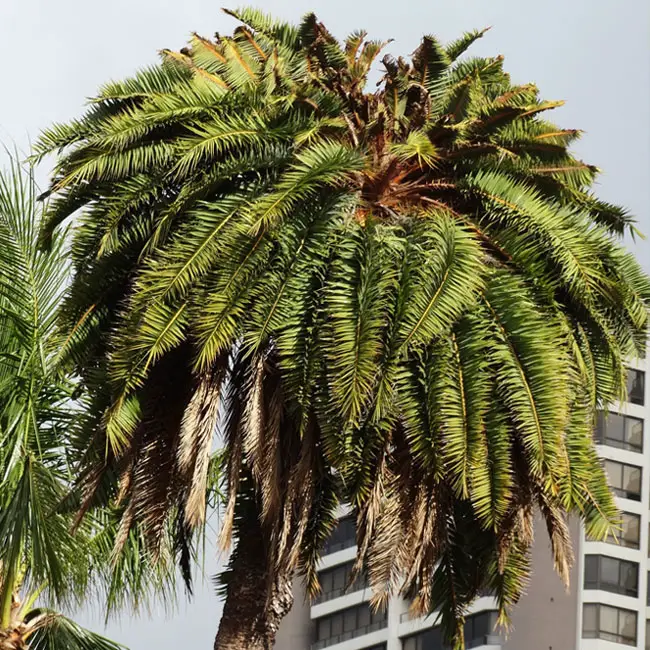
If water levels don’t seem to be the issue, the next aspect to consider is nutrient deficiency. As you’re aware, the key elements crucial for palm health include Nitrogen (N), Phosphate (P), Potassium (K), Magnesium (Mg), Manganese (Mn), and Iron (Fe).
According to research from the University of Florida research, the only reliable method for identifying nutrient deficiencies is through a visual examination of the palm’s leaves, although this can be challenging when mineral deficiencies overlap. By the way, soil analysis doesn’t provide insight into palm nutrient balance, rendering soil testing ineffective.
- In the case of Nitrogen (N) deficiency, you’ll observe abnormally yellow-greenish fronds.
- For Potassium (K) deficiency, yellow spotting appears on older leaves.
- Magnesium (Mg) deficiency causes the tips to become bright yellow.
- Manganese (Mn) deficiency leads to “frizzletop,” which manifests as deformed new leaves with brown areas.
- Iron (Fe) deficiency is marked by new leaves turning yellowish with green veining.
Palm trees should be fertilized during the growing season, which typically spans from the end of March to the end of October, using a high-quality slow-release fertilizer. The frequency of palm fertilization depends greatly on soil type and the amount of rainfall in your region.
5. Cold Damage
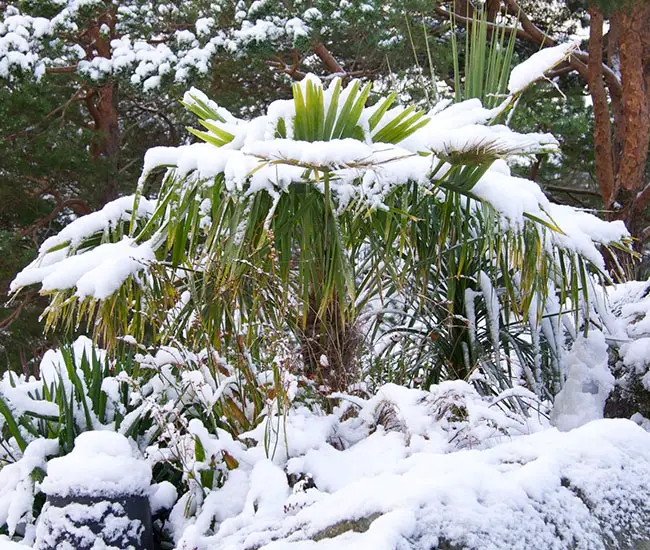
During unexpected cold snaps, providing timely winter protection can be challenging. If your palm has been affected by freezing temperatures, you’ll notice symptoms like drooping, wilting, or browning of the older leaves. In severe cases, new growth might turn brown, black, or emerge deformed.
It may take months for the extent of the damage to become apparent. Unfortunately, there isn’t much you can do retrospectively, but you can protect your palm from future cold snaps and apply antibacterial spray to prevent the development of fungi or bacteria.
6. Fertilizer Burn
Excessive fertilizer application can harm the roots, resulting in the browning of tips and fronds. If the fertilizer is placed too close to the trunk, it can even damage the trunk itself, significantly weakening the palm and making it susceptible to insects and diseases.
To avoid this, only fertilize palms during the growing season with a high-quality, slow-release fertilizer.
Ensure that the fertilizer is applied at least 2 feet away from the trunk. If you notice any trunk damage, promptly treat the area with an antibacterial or antifungal spray.
7. Transplant shock
It’s entirely normal for newly planted palms to go through a period of “transplant shock” due to factors like root loss, water loss, changes in light levels, temperature variations, and shifts in humidity levels. So, if you see your newly planted palm turning brown or yellow, don’t be alarmed.
If you’ve planted it correctly, ensuring good drainage and soil quality, it should bounce back fairly soon. In fact, you usually don’t need to do anything special. Avoid fertilizing it for the first two months while it’s settling into its new location.
8. Sunburn
Before planting a new palm in full sun, it’s advisable to acclimate it gradually for a few weeks to prevent sunburn. Otherwise, the intense sunlight can cause the fronds to become yellow and lose their vibrant color.
To acclimate the palm, initially place it in a shaded spot and slowly increase the exposure to light each week. If the palm isn’t very tall, you can also shield it with plastic, gradually adding more holes in the plastic to allow increasing light levels.
If your palm has already experienced sunburn, leave the damaged fronds on the tree. Over time, your palm will adapt to its new environment and recover, usually within a few months.
9. Insect Attack
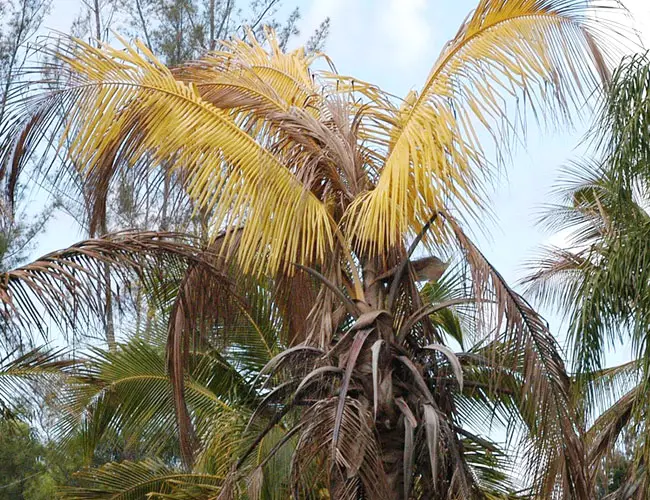
Healthy palms naturally resist insect infestations and diseases, but they can become vulnerable to attacks when under stress. Among the most common intruders are scale insects, spider mites, and mealybugs.
Thankfully, when it comes to palm trees, insect pests are more of a nuisance than a severe threat. They typically cause minimal harm, and the palm usually outgrows any damage they inflict.
To deal with these pests, carefully inspect the leaves to see if you can spot the insects. If you do, you can eliminate them by spraying the affected areas with insecticidal soap.
10. Diseases
The most prevalent diseases affecting palms are caused by various fungi. Two notable examples are Ganoderma butt rot and fusarium wilt. In the case of fusarium wilt, you’ll notice that the leaflets on only one side of the leaf stem of the oldest leaves turn brown, followed by the development of a reddish or dark brown stripe along the leaf stem.
Unfortunately, both Ganoderma butt rot and fusarium wilt have no effective treatment. Another grave concern is lethal yellowing, which leads to leaves turning yellow, grey, or brown, starting with the old fronds and progressing to the new leaves.
Additionally, there are several leaf spot fungi that cause yellow or dark brown spots on leaflets, primarily affecting stressed palm trees.
Resolving the underlying stress factors can often resolve this issue. Furthermore, you can consider applying fungicidal sprays containing copper hydroxide or copper salts of fatty acids, which may help combat these fungi.
Why Is My Newly Planted Palm Tree Is Turning Brown
As previously noted, it’s common for newly planted palms to experience a condition known as “transplant shock.” This occurs because when palms are transplanted, their roots are disturbed and exposed to the air, leading to a significant loss of roots and resulting in water stress.
Additionally, newly planted palms need time to adapt to their new environment, including the soil, light conditions, and humidity levels.
Therefore, it’s not unusual for a newly planted palm to exhibit symptoms such as yellowing, browning, or drooping leaves.
While you can’t entirely prevent transplant shock, there are measures you can take to minimize its impact by helping the palm acclimate to its new surroundings.
One effective approach is to acclimate the palm gradually over a few weeks. Start by placing the palm in its new location, then slowly increase the amount of light it receives over time.
When transplanting the palm into the soil, try to disturb the root ball as little as possible, and there’s no need to remove the old soil.
In the initial stages, water the palm daily for the first week, then every other day for the second week, before transitioning to its regular watering schedule.
Deep watering is especially beneficial. It’s also advisable to refrain from fertilizing the palm for the first two months.
By following these planting instructions, you can help your palm minimize the effects of transplant shock and improve its chances of thriving in its new home.
Should I Cut Off Brown Palm Leaves
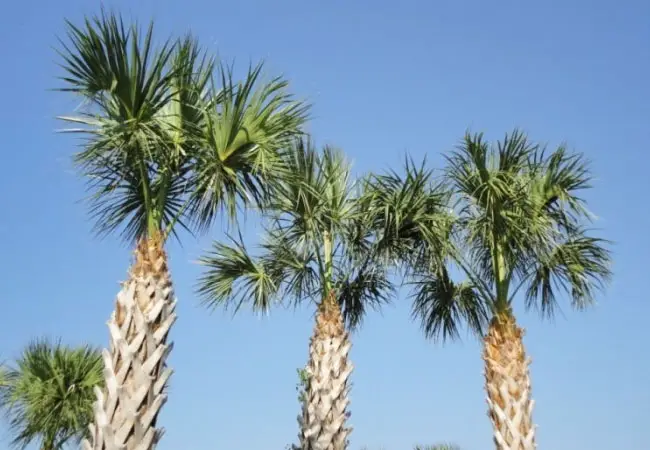
Online articles often suggest cutting off brown tips or leaves to save palm trees from wasting nutrients on dying foliage. Sounds logical, doesn’t it? But it’s not quite that simple!
Palm trees actually rely on old leaves for nutrients, so when you trim them, your palm may experience stress. Palms, especially potassium (K), move nutrients from older fronds to fuel new growth.
Pruning isn’t necessary for all palms. Those with crownshafts – a smooth area at the top of the trunk formed by tightly clasping leaf bases – should never be pruned since they naturally shed old brown leaves. These are known as ‘self-cleaning’ palms.
A leaf can go from green to completely orange-brown in just a few days and then fall off on its own – that’s a natural cycle.
Palms without crownshafts have a similar cycle, but dead leaves cling to the trunk and may need manual removal. Only trim them when they are completely brown and dry!
When you do prune, cut as close to the trunk as possible and avoid removing fronds growing at a 45-degree angle or greater. If your palm starts resembling a rooster tail, you’ve over-pruned it.
By the way, according to research from the University of Florida, removing palm flowers or fruits can lead to increased leaf production.
If You Cut a Palm Tree in Half, Will It Grow Back?
Some gardeners believe that cutting a palm tree in half will encourage better root development and strengthen the palm. However, this isn’t the case.
If you cut a palm tree’s trunk in half, it won’t regenerate; it will die. Palms can’t heal themselves when their trunk is injured.
The growing point, known as the bud or heart, is situated near the top of the trunk and is connected to the vascular system. Removing the heart means the palm can’t produce another one, leading to its demise.
Can Brown Palm Leaves Turn Green Again?
While you can revive a dying palm tree, brown or yellow leaves NEVER turn green again. hue. You’ll have to wait for the palm to grow new fronds to replace the damaged ones. As mentioned earlier, only remove brown leaves when they are completely dry.
Keep an eye on the new growth emerging from the bud (the palm’s ‘heart’). If it appears healthy and green, the problem is resolved. If the tips of the emerging fronds start turning brown, the issue persists.
While there’s little you can do about brown leaves, drooping leaves will become upright again once the underlying problem is resolved.
Why Are Majesty Palm Leaves Turning Brown
The Majesty Palm (Ravenea rivularis) originates from Madagascar, a sizable island situated in the Indian Ocean along the eastern coast of southern Africa, to the east of Mozambique.
There this palm thrives in moist areas such as riverbanks and humid valleys. To reach its full potential, Majesty palm requires ample water, good drainage, and plenty of fertilizer.
A lack of nitrogen can lead to yellow leaves. It also prefers full sun or partial shade. Overwatering or underwatering can result in brown tips and leaves.
Many people choose Majesty Palms as indoor plants due to their manageable size, but they do demand humidity. Dry air can cause their tips to turn brown.
If your Majesty Palm is displaying brown or yellow leaves, start by reviewing its basic care requirements. Try to replicate its natural habitat as closely as possible, and protect it from sudden cold spells, as it thrives in warm conditions.
Why My Areca Palm Tree Has Brown Tips and Yellow Spots
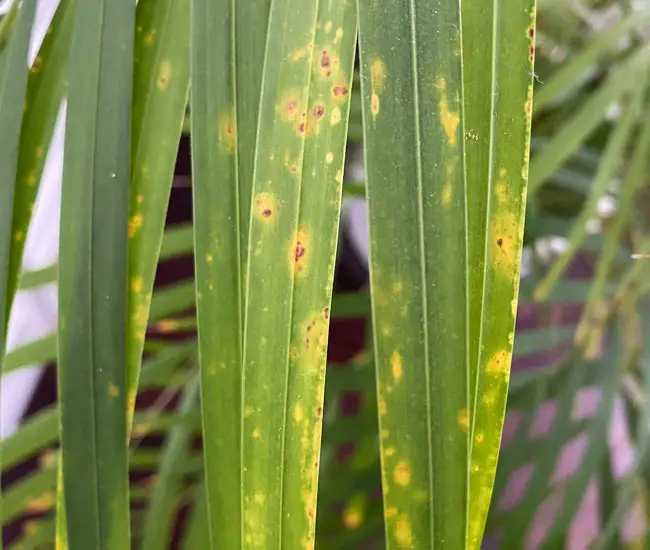
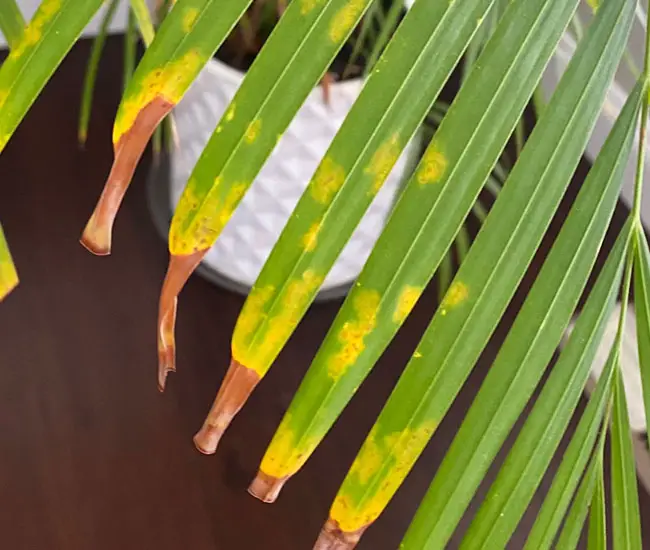
If your indoor Areca palm resembles the one in the picture above, it’s dealing with multiple issues.
The brown tips are a result of both under-watering and insufficient humidity, while the presence of yellow and brown spots indicates a potential deficiency in potassium, and possibly magnesium. Fortunately, the deficiency doesn’t seem severe since there are no black spots yet.
How do I know this? Well, this Areca palm has been residing at my mom’s house for the past seven years, and I can vouch for her occasional forgetfulness when it comes to watering. It also happens to sit right next to a floor vent that blows hot air directly onto the plant.
Moreover, she has never given it any fertilizer, and it’s only recently been moved to a larger container.
I must say, the Areca palm has proven to be quite the resilient indoor plant. By the way, I’ve taken it into my house and will do my best to restore its beauty.
Pictures Of Sick Palm Tree Leaves
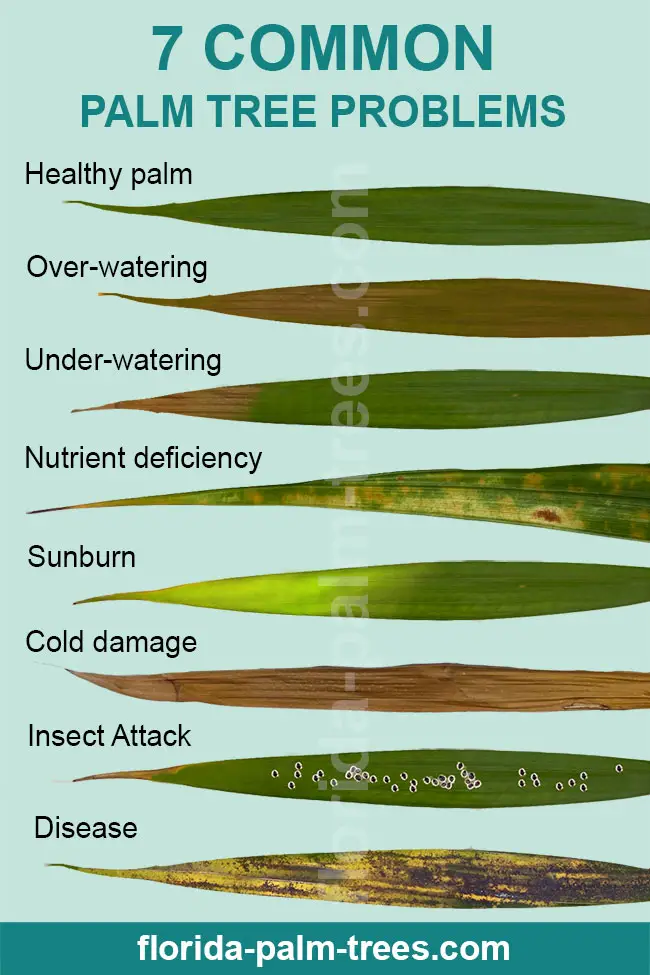
Final Thoughts
As you can see, established palm trees encounter different issues than newly planted ones. Mature palms don’t grapple with acclimatization problems like adjusting to new soil, humidity levels, or light conditions. They’ve been in their current location for a while and are accustomed to the environment.
Additionally, any watering and drainage concerns have likely been resolved. That said, if your established palm starts showing signs of browning or yellowing, it’s most likely due to nutrient deficiencies or cold damage.
Related articles:
–Top 10 Palm Tree Care Mistakes and How To Avoid Them
–Top 10 Palm Tree Planting Mistakes You Don’t Want To Make
–5 Most Common Nutrient Deficiencies In Palms (with Pictures)
–Expert Tips: How And When To Fertilize Palm Trees
–5 Steps To Saving Freeze Damaged Palm Tree
